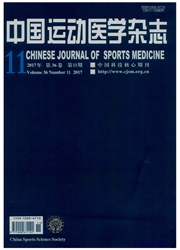

 中文摘要:
中文摘要:
目的:观察穴位电刺激预处理对超负荷训练大鼠心肌PKCδ和PKCε表达的影响,探讨穴位电刺激预处理保护运动心脏的分子生物学机制。方法:23只3月龄雄性SD大鼠随机分为3组:空白对照组(n=5)、超负荷训练组(n=9)和穴位电刺激预处理组(n=9)。空白对照组不予任何处理;超负荷训练组和穴位电刺激预处理组进行8周游泳训练,穴位电刺激预处理组在每次训练前先行穴位电刺激,20 min/次,取穴相当于内关和足三里。空白对照组在实验结束时,其它两组在超负荷训练4、6、8周时取材,应用免疫组化法观察各组心肌组织PKCδ和PKCε表达情况。结果:4、6、8周时,超负荷训练组和穴位电刺激预处理组心肌细胞PKCδ表达与空白对照组比较均上升(P〈0.05),但穴位电刺激预处理组6、8周明显低于超负荷训练组(P〈0.05)。三个时间观察点,超负荷训练组PKCε表达呈逐渐下降趋势,8周末明显低于空白对照组(P〈0.05),而穴位电刺激预处理组PKCε表达均保持在较高水平,显著高于空白对照组(P〈0.05)。结论:穴位电刺激预处理可抑制超负荷训练后大鼠心肌PKCδ过度表达,同时维持PKCε高表达,这可能是其具有心肌保护效应的机制之一。
 英文摘要:
英文摘要:
Objective To investigate the effects of preconditioning with acupoint electrical simulation on the myocardial PKCδ and PKCε expression of rats during overload training and the possible molecular mechanisms of cardioprotective effects of the stimulation.Methods A total of 23 male three-month-old SD rats were randomly divided into three groups: group A(n = 5,control),group B(n = 9,8-week overload training),group C [n=9,8-week preconditioning with acupoint electrical simulation,20 minutes on Neiguan(pc 6) and Zusanli(st 36)before training].Materials in group B and C were drawn in the 4th,6th and 8th week,and in group A in the 8th week.Immunohistochemistry were used to detect the myocardial PKCδ and PKCε expression.Results PKCδ expressions in group B and group C were significantly higher than in group A at the 4th,6th,and 8th week(P 0.05),while in group C was significantly lower than in group B at the 6th and 8th week(P 0.05).PKCε expression in group B decreased gradually from 4th to 8th week,and was significantly lower than in group A by the end of the 8th week(P 0.05),while PKCε expression in group C were remained unchanged,and was significantly higher than in group A by the end of the 8th week(P 0.05).Conclusion Our results demonstrated that preconditioning with acupoint electrical stimulation inhibit overexpression of myocardial PKCδ and maintain higher expression of PKCε in rats during overload training,which may be one of the major mechanism of cardioprotective effects of preconditioning with acupoint electrical stimulation.
 同期刊论文项目
同期刊论文项目
 同项目期刊论文
同项目期刊论文
 期刊信息
期刊信息
